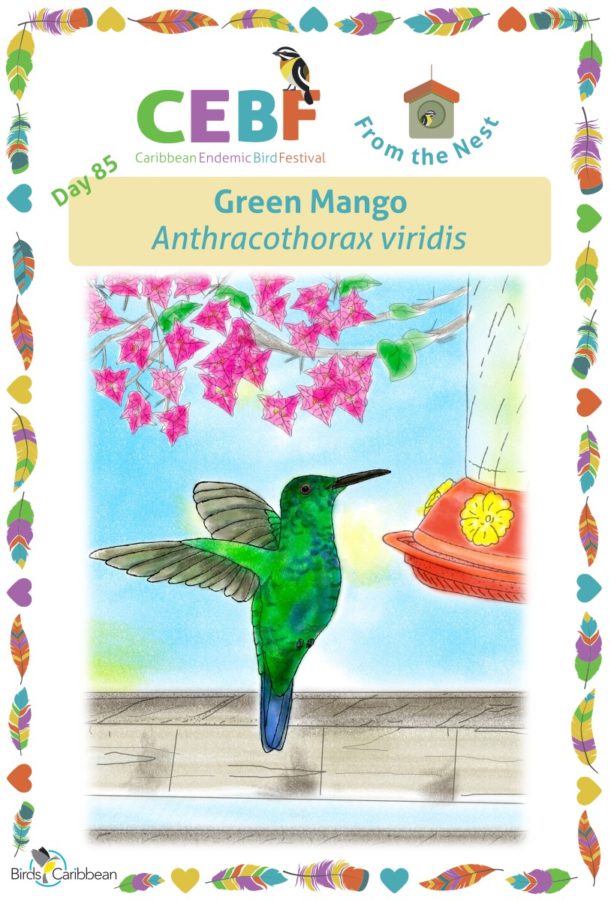Celebrate the Caribbean Endemic Bird Festival (CEBF) with us! Our theme in 2022 is “Loving Birds is Human Nature”. Have fun learning about a new endemic bird every day. We have colouring pages, puzzles, activities, and more. Download for free and enjoy nature with your family at home.
Endemic Bird of the Day: Green Mango
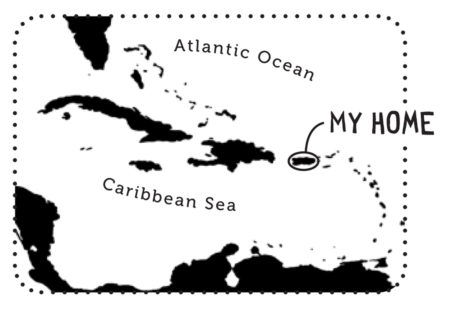 Today, we’re in search of a Green Mango – and we don’t mean the well-known tropical fruit! The Green Mango (Anthracothorax viridis) is one of two endemic hummingbird species that inhabit Puerto Rico – the other being the Puerto Rican Emerald (Chlorostilbon maugaeus). A total of five hummingbird species can be found on the island, but they are segregated by geographical areas, elevations, habitats and preferences for flower resources. The Green Mango is a forest specialist, look for it in montane habitats, forest edges, and shade coffee plantations of the central and western parts of the island.
Today, we’re in search of a Green Mango – and we don’t mean the well-known tropical fruit! The Green Mango (Anthracothorax viridis) is one of two endemic hummingbird species that inhabit Puerto Rico – the other being the Puerto Rican Emerald (Chlorostilbon maugaeus). A total of five hummingbird species can be found on the island, but they are segregated by geographical areas, elevations, habitats and preferences for flower resources. The Green Mango is a forest specialist, look for it in montane habitats, forest edges, and shade coffee plantations of the central and western parts of the island.
The Green Mango is a large dark-green hummer (11-12 cm, 6-7 g) with a black, down-curved bill, and rounded tail. Its upperparts are glossy emerald-green, underparts metallic blue-green, and tail metallic blue-black. The sexes look alike; the only difference is the presence of a tiny white eye spot in adult females.
The Green Mango might be confused with the similar-sized Antillean Mango which also has a curved, black bill. However, they are easy to tell apart. The Antillean Mango is lighter green above. The male has black underparts, iridescent green throat, and dark purple tail. The female is whitish-gray below with whitish tail tips. Although both species overlap in habitats at mid-elevation, the Antillean Mango is mainly found in the coastal scrub, open habitats and gardens at lowlands.
Green Mangos feed on insects, spiders, and nectar; and are particularly fond of Heliconia flowers. They are “trapliners,” which means that they forage on widely dispersed flowers that last only one day. Thus, they rely on extended blooming periods of individual plants. This species is the primary pollinator of flowers with long-tube corollas, like those of native bromeliads and Heliconias. They aggressively defend territories of flowering plants with high sugar content in the nectar (often red and tubular-shaped flowers). Males are known to defend their feeding area, often an entire flowering tree!
The female builds a cup-shaped nest with woven plant fibers lined with lichen. She lays two white eggs and incubates and feeds the chicks with regurgitated food, mostly insects. The chicks leave the nest when they are about 20 days old.
The Green Mango is listed as Least Concern by the International Union for the Conservation of Nature (IUCN). It is a restricted range species, however, and thus vulnerable to impacts from severe storms and hurricanes, which may damage its habitats and food sources. Learn more about this species, including its range, photos, and calls here.
Colour in the Green Mango
Download our West Indies Endemic Bird colouring page. Use the photos below as your guide, or you can look up pictures of the bird online or in a bird field guide if you have one. Share your coloured-in page with us by posting it online and tagging us @BirdsCaribbean #CEBFfromthenest
Listen to the calls of the Green Mango
The calls of the Green Mango include a high-pitched twitter and can also include rattling or chattering notes.
Puzzle of the Day
Click on the image below to do the puzzle. You can make the puzzle as easy or as hard as you like – for example, 6, 8, or 12 pieces for young children, all the way up to 1,024 pieces for those that are up for a challenge!
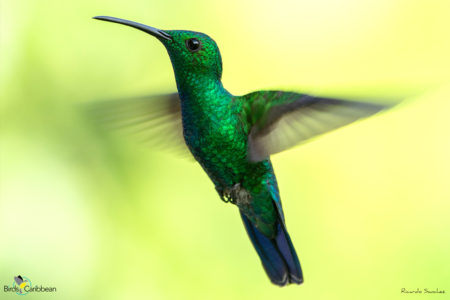
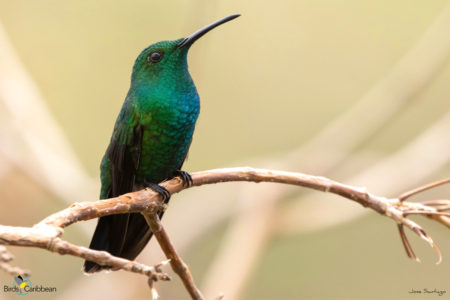
Activity of the Day
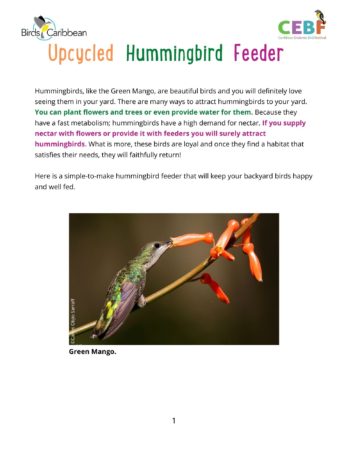 FOR KIDS AND ADULTS: Green Mangos love to feed on nectar! Why not try making this hummingbird feeder? You can can fill it with home-made nectar, and hang in your garden to keep the hummingbirds well fed. Be sure to follow our nectar recipe carefully so that your hummingbirds get the correct levels of sugar in their food! Not in Puerto Rico – the home of these beautiful endemic hummingbirds? No problem, hummingbirds that live near you will love this feeder! Hang it out, fill it with nectar and see who comes to visit for lunch. Remember that this activity involves using scissors and an electric drill, so you will need an adult to help with making this.
FOR KIDS AND ADULTS: Green Mangos love to feed on nectar! Why not try making this hummingbird feeder? You can can fill it with home-made nectar, and hang in your garden to keep the hummingbirds well fed. Be sure to follow our nectar recipe carefully so that your hummingbirds get the correct levels of sugar in their food! Not in Puerto Rico – the home of these beautiful endemic hummingbirds? No problem, hummingbirds that live near you will love this feeder! Hang it out, fill it with nectar and see who comes to visit for lunch. Remember that this activity involves using scissors and an electric drill, so you will need an adult to help with making this.
Once you have made your hummingbird feeder make sure that you follow the “Hummingbirds Feeder Tips” given in the instructions, so that your feeder is hung in the right place for the birds and is kept safe and clean for them to feed from.
Even if you aren’t able to make this feeder or don’t live in a place where there are hummingbirds you can still enjoy this video of a Green Mango in the wild!

